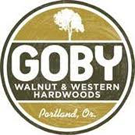
WHAT'S TRENDING: BURLY BIG LEAF MAPLE
After Walnut, Big Leaf Maple is probably the tree we see the most here at the mill. We just got a bunch of burly Big Leaf Maple pieces in our store, so I figured it’d be a good opportunity to highlight this beautiful timber.
Big Leaf Maple trees grow prolifically here, from the middle of British Columbia, Canada to the Sierra Nevada Mountains in California. And they grow big- the average diameter of maple logs we get here at Goby is around three feet across. They also grow a lot faster than most species here. In the first 15 years of a Maple tree’s life, they can gain three feet of height per year, and still grow one to two feet per year after that.
 Because they grow so fast, Big Leaf Maple also has a better chance than other species to develop burls- those weird growths on the trunks of trees you see sometimes. We went in-depth about burl a few months ago, which you can read here. In short, a burl is a nodule that randomly forms on a tree trunk, which can have beautifully figured wood inside. Sometimes, instead of a single, large burl forming, Big Leaf Maple trees can have multiple smaller burls up and down the trunk. Again, how and why burls form isn’t very well understood; multiple theories suggest causes like cuts or stress to the trunk, soil content, insect damage, and so on.
Because they grow so fast, Big Leaf Maple also has a better chance than other species to develop burls- those weird growths on the trunks of trees you see sometimes. We went in-depth about burl a few months ago, which you can read here. In short, a burl is a nodule that randomly forms on a tree trunk, which can have beautifully figured wood inside. Sometimes, instead of a single, large burl forming, Big Leaf Maple trees can have multiple smaller burls up and down the trunk. Again, how and why burls form isn’t very well understood; multiple theories suggest causes like cuts or stress to the trunk, soil content, insect damage, and so on.
Burly Maple is pretty rare; out of all the maple logs we get, maybe 1 in 20 will have burls attached. And even then, getting usable lumber out of that log isn’t a sure thing. Because Big Leaf Maple grows so big, so fast, it tends to absorb a lot more water than other hardwood trees. If a tree has too much water in it, this can cause it to rot on the inside. That 1 in 20 (5%) chance of burl starts looking more like 1 in 30 (3%), or even 1 in 50 (2%) when you factor in how many maple trees we see that are rotted inside.

One trend we’ve seen gain steam lately is the “epoxy table”, where two (or more) pieces with a live edge are turned inward, and the void in between is filled with tinted epoxy resin. These tables are all over social media these days, so they’re hard to miss.
As of this writing (March 11, 2019), we’ve got almost 600 board feet of burly Big Leaf Maple in the store, kiln dried and ready to be worked. Most of the material is 8/4 – 10/4 in thickness, with live edge on 1 or 2 sides. Click the link to learn more!
